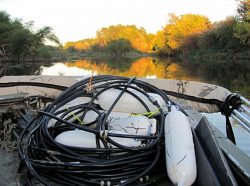Electrical resistivity (ER) to characterize groundwater-surface water interactions
Michael Markowski

The goal of my study is to use electrical resistivity (ER) to characterize groundwater- surface water interactions along the Lower Colorado River at Hornsby Bend; just east of Austin, Texas. Here the river is said to be controlled-dam operations from upstream induce the water in the channel to rise and fall again by as much as 2-3 meters everyday. The daily reversals of water level in the river channel affects the hydrological dynamics of the surrounding aquifer and the zone of groundwater- surface water exchange, called the hyporheic zone. Here, in the hyporheic zone, flow is reversed from toward the river to away from the river in accordance with the stage fluctuations. This zone of exchange also becomes larger in its horizontal and vertical extent in accordance with stage fluctuations.
Electrical resistivity can be used to differentiate between groundwater and surface water, and furthermore to characterize the zone of mixing (and its changes over time) between the two. This is because groundwater along the Colorado has a higher amount of total dissolved solids (TDS), making groundwater less electrically resistive than the lower TDS surface water coming from upstream and from the dam reservoir.

I used two different surveying techniques.
First I conducted continuous resistivity profiling
(CRP). This involved towing an ER cable behind
a boat repeatedly over a 24 hour cycle. The
next step was to use a stationary ER cable that made a transect across the river and also took measurements for a 24 hour cycle. The CRP allows for large spatial scale and the stationary profile allows for vary precise measurements. Again, both methods were conducted for a 24 hour period to capture the effects over one stage reversal.
Time-lapse stacking of the stationary resistivity transects show significant changes in resistivity within the uppermost 2.0 m of substrate located immediately below the sediment-water interface. Results from the CRP profiles indicate that this exchange can be detected over an even larger spatial scale. These results show electrical resisitvity as a powerful tool for better under-standing the effects of oscillating river stage on hyporheic processes.
This study is important for many reasons. An estimated 60% of the world’s major rivers are dammed. Hydrological impacts within the hyporheic zone caused by dam operations are not well understood. These effects disrupt the natural biogeochemical conditions, which have major implications for river ecology.